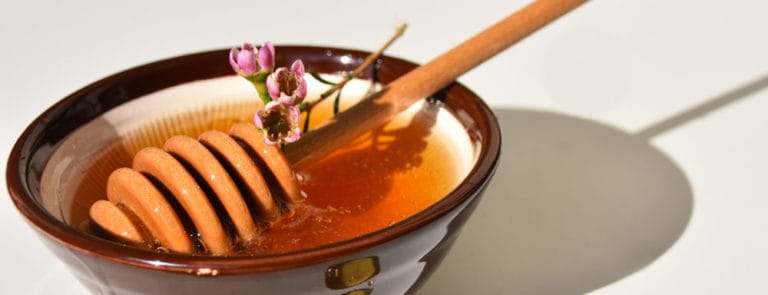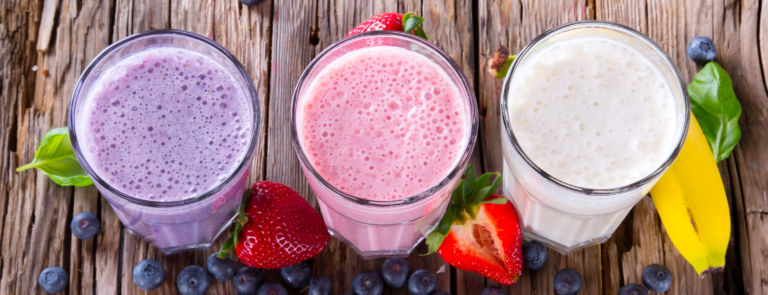10% off £35
Manuka honey guide: Benefits, MGO, UMF, NPA, strengths & reviews

What does MGO stand for in Manuka honey? And what’s happened to UMF and NPA?
Find the answers to these questions & discover the health benefits of Manuka honey right here – buzzing!
What is Manuka honey?
Manuka honey is a special type of honey that comes from New Zealand, but you can also find it in Australia.
The discerning little bees who make Manuka honey collect most of their nectar (the base of all honey) from the Manuka bush (Leptospermum Scoparium).
The Manuka bush is where this premium honey gets all its unique properties, including its rich flavour and associated health benefits – we’ll get into these below!
Top 3 manuka honey benefits
Manuka honey is used for all sorts of things. We've listed the top 3 benefits below:
-
Antibacterial properties
All types of honey are known for their antibacterial properties, but Manuka honey takes it to a whole new level! The special ingredient? MGO.
MGO aka methylgloxal, is where Manuka honey get’s all its antibacterial power from.
In regular table/runny honey, the hydrogen peroxide activity breaks down in processing/storage, meaning a lot of the anti-bacterial benefits get lost.
However, Manuka honey has MGO up its sleeve, so its antibacterial properties remain even after the hydrogen peroxide has broken down.
-
Calms and soothes sore throats
Does a cough or cold have you reaching for your favourite mug and pot of honey?
Turns out that hot tea and honey isn’t just an old wives’ tale!
Honey can really help soothe your throat – especially if it’s Manuka honey.
Can’t find your usual sore throat relief? When over-the-counter cold and flu medicines run low, why not try Manuka honey to soothe sore throats and help support your immunity. Our range is highly moisturising and antibacterial - sounds like a skincare product, right?
-
Soothes skin
Highly moisturising, antibacterial and 100% natural – sounds like a skincare product, right?
Well it turns out Manuka honey can do wonders for your skin on the outside as well as nourish your body from the inside!
Its antibacterial properties can help to combat bacteria binding to irritated skin, which ultimately helps the healing process.
And it will leave your skin feeling lovely and soft too.
Why not try out these 5 Manuka honey face masks and see for yourself?
Summary
- Manuka honey is a unique type of honey made in New Zealand (and Australia) by bees who frequent the Manuka bush
- It is known for its high quality and potent antibacterial properties, which can help soothe sore throats
- People also use it in face masks/skincare products to moisturise and combat potential skin concerns
How to choose Manuka honey
First things first, you should find out if your Manuka honey is what it says it is – there are a lot of fakes out there.
How can I be sure I'm buying genuine Manuka honey?
We’ve always insisted on seeing documentation proving Manuka honey sold in Holland & Barrett stores is genuine. The New Zealand government has now brought in more strict legislation around Manuka honey and how it’s labelled, and all Manuka honey exported from New Zealand must now be laboratory-tested to prove it’s authentic.
The tests check for:
- four active ingredients only found in Manuka honey
- the DNA of Manuka pollen
All the Manuka honey we sell carries authenticity stamps, which shows that the honey has passed these stringent lab tests.
Which Manuka honey is best?
The best Manuka honey will be both genuine and strong.
Now you know how to distinguish a dud Manuka honey from a genuine product, the next thing you want to look at is the MGO/UMF/NPA strength.
What are the Manuka honey grades?
Manuka honey is usually graded by MGO, UMF, or NPA.
All of these grading systems are ways to demonstrate the antibacterial properties, quality and potency of each batch of Manuka Honey, so you know exactly what you’re buying.
MGO vs UMF vs NPA
Each rating differs slightly but what they are measuring is largely the same, which is why they are often interchangeable on labels, e.g. a 140 MGO Manuka honey would have a 6+ UMF. Find out more about each below.
What is MGO in Manuka honey?
MGO, or methylgloxal, is the magic ingredient in Manuka honey, with well-documented antibacterial and antimicrobial properties.
All natural honey has some antibacterial effects, but scientists have discovered that Manuka's effects are much more potent, thanks to MGO.
The antibacterial properties of honey are provided by hydrogen peroxide. In normal table honey, the hydrogen peroxide activity breaks down, meaning the anti-bacterial benefits are lost.
But in Manuka honey, thanks to MGO, the antibacterial properties remain even after the hydrogen peroxide has disappeared.
Manuka honey comes in a range of MGO ratings. The higher the number on the label, the better the health benefits and anti-bacterial properties are.
What is UMF in Manuka honey?
A lot of Manuka honey is graded by the UMF grading system set up by the ‘Unique Manuka Factor Honey Association’ in New Zealand.
The Unique Manuka Factor looks at 2 main components of this honey:
- Label: the label’s claim that the product is genuine Manuka honey.
- Number: the unique signature compounds characteristic of Manuka honey, which ensure quality and purity. These include: Leptosperin, DHA and MGO.
The honey is then given a number from UMF 5+ to UMF 20+. The higher the UMF raring, the more antibacterial activity the honey has and the more potent it is.
What is NPA in Manuka honey?
NPA stands for the Non-Peroxide Activity of honey, which is another way to classify the potency and quality of Manuka honey.
This classification came to be in 1981 when Dr Peter Molan started researching the peroxide activity in honeys from around the world.
He wanted to find out what happened when he deliberately destroyed the Hydrogen Peroxide Activity (HPA) in honey.
He found that most types of honey without HPA experienced a decline in antibacterial activity, but Manuka honey retained strong antibacterial activity.
What strength is best for Manuka honey?
It totally depends what you’re looking for in your Manuka honey. The general rule is: the higher the rating, the stronger the antibacterial properties.
What MGO rating should I choose?
At Holland & Barrett, we've simplified the Manuka honey that we sell. This means you will only see MGO ratings on our labels and not UMF or NPA. If you've previously bought UMF or NPA-rated Manuka honey, then here is a simple chart that shows you the corresponding MGO level.
MGO to UMF/NPA comparison table
| MGO Level | UMF number / NPA grade |
|---|---|
| 85 MGO | 5+ |
| 140 MGO | 6+ |
| 240 MGO | 8+ |
| 300 MGO | 10+ |
| 525 MGO | 15+ |
| 850 MGO | 20+ |
Summary
- MGO, UMF and NPA are all ways that Manuka honey can be classified and compared
- Generally, the higher the rating, the higher the antibacterial activity you can expect
- Here at H&B, we have chosen to focus on MGO to help keep it simple!
Is Manuka honey worth the price tag?
That’s for you to decide!
At the end of the day, if you want a high-quality honey with unmatched antibacterial properties, you are probably going to have to spend more money than you would if you went for your average run-of-the-mill table honey.
Whether it’s worth the price tag is totally up to you.
Can you eat raw Manuka honey?
Yes, in fact, eating Manuka honey raw is the best way to reap all the benefits of this golden treat.
Try eating it by the spoonful straight from the jar for unrivalled freshness or mixing it into a smoothie/yoghurt /cereal/salad dressing to maintain its purity.
However, if you’re taking Manuka honey for a cold and don’t fancy it a la spoon, try mixing it into hot tea with a squeeze of fresh lemon to soothe that scratchy throat.
Need some more Manuka inspiration. Check out 10 ways to supercharge your day with Manuka honey.
Where to buy Manuka honey
Most large supermarkets and health food stores will stock Manuka honey. However, if you’re looking for a range of strengths and brands to peruse, take a look at our selection here at H&B.
Handpicked article: 10 of the best manuka honey products of 2021
Overview
- Manuka honey is a unique type of honey made in New Zealand (and Australia) by bees who frequent the Manuka bush
- It is known for its potent antibacterial properties, which can help soothe sore throats and coughs
- People also use it in skincare products/face masks to moisturise and combat potential skin concerns
- MGO, UMF and NPA are all ways that Manuka honey can be classified and compared
- Generally, the higher the rating, the higher the antibacterial activity you can expect
- Here at H&B, we have chosen to focus on MGO to help keep it simple!














